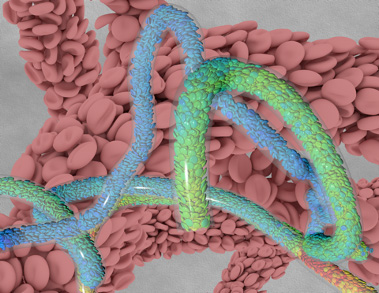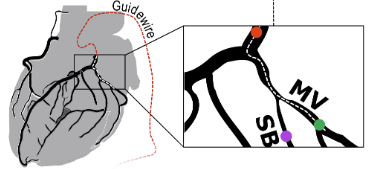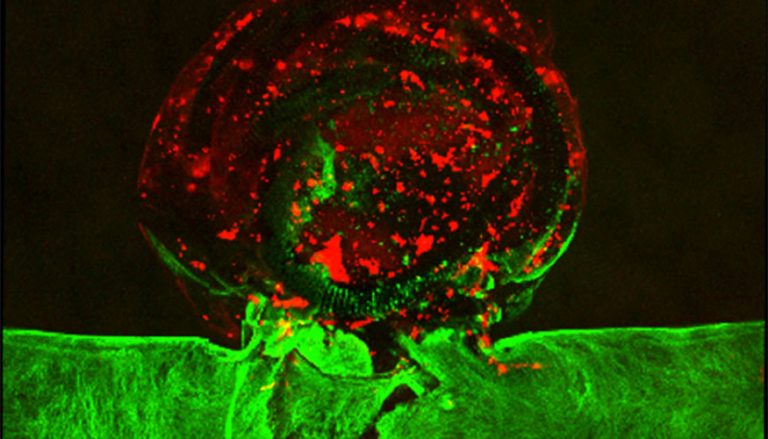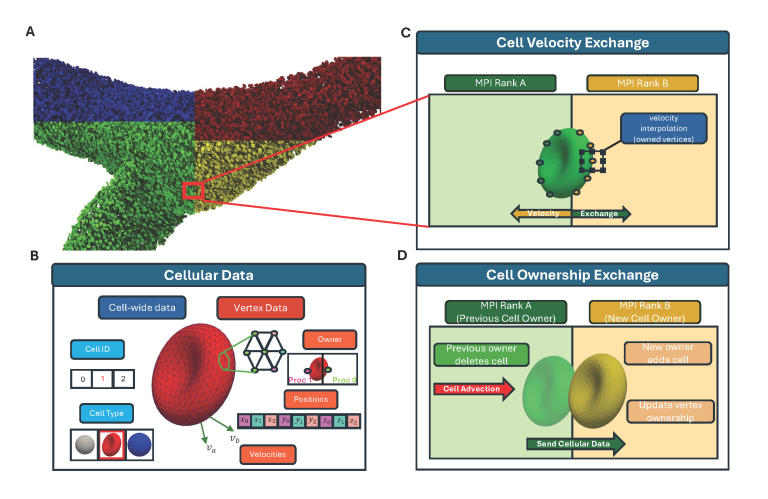High Performance Computing
High performance computing (HPC) is a cornerstone technology at the Center for Computational and Digital Health Innovation, enabling groundbreaking research and discoveries in medicine. HPC encompasses a broad range of advanced computing capabilities, from single GPUs to the world’s largest supercomputers. This technology allows researchers to overcome significant engineering challenges, tackle larger spatial domains, and extend the temporal scope of their studies. By reducing overall runtime, HPC enables real-time feedback and accelerates the pace of medical research. Here we highlight several representative projects showing how HPC is being utilized at the Center to advance medical science and improve patient care.
Simulating Complex Biomedical Processes
The Randles Lab utilizes HPC to address complex biomedical challenges, such as simulating blood flow trajectories in digital twins. The lab achieved a groundbreaking milestone by completing the first-ever 3D blood flow simulation on the scale of the full human body, a feat that earned them recognition as Gordon Bell Finalists. Their work extends both the spatial scope and time domains captured by computational models, ranging from meter-length scales down to individual ligand-receptor pairings. By leveraging leadership-class supercomputers, the lab develops advanced software capable of handling high-fidelity fluid-structure interaction simulations. These capabilities allow researchers to explore disease mechanisms at unprecedented resolutions and scales.
The Randles Lab focuses on large-scale parallel computing and ensuring the portability of their models across different supercomputing systems, including Intel, AMD, and NVIDIA platforms. This effort ensures that their findings are accessible and applicable across a range of computing environments. The use of HPC transforms the types of questions researchers can ask, facilitating discoveries that would be otherwise unattainable.
Real-Time Computing for Neural Speech Prostheses
The collaborative efforts between the Viventi and Cogan Labs focus on developing advanced neural interfaces and real-time computing solutions to restore communication for patients with neurodegenerative diseases. These patients often lose the ability to speak, severely impacting their quality of life. The team addresses this challenge by utilizing high-resolution, micro-electrocorticographic (µECoG) neural recordings to capture detailed brain activity during speech production. This novel approach provides neural signals with significantly higher spatial resolution and signal-to-noise ratio compared to standard invasive recordings, resulting in nearly double the decoding accuracy.
The use of advanced computing techniques, including non-linear decoding models, leverages the rich spatio-temporal structure of these neural signals to enhance speech decoding. The real-time aspect of this research is crucial, as it enables the development of neural speech prostheses that can operate in real-time, allowing for immediate feedback and communication. Additionally, the project addresses the unique challenges of deploying these systems in environments without reliable Wi-Fi connectivity, ensuring that the technology can be used effectively in various settings. The interdisciplinary collaboration between the medical and engineering schools at Duke enhances the development and application of these cutting-edge technologies, providing new hope for patients with speech impairments.

Advancing Machine Learning in Biomedical Research

The Chatterjee Lab harnesses the power of HPC and GPUs to develop advanced machine learning models for biomedical applications. The lab focuses on three main areas: Programmable Proteome Editing, Programmable Genome Editing, and Programmable Cell Engineering. By leveraging GPUs, the lab can efficiently train generative language models such as Cut&CLIP, SaLT&PepPr, PepPrCLIP, and PepMLM. These models enable the design of peptide-guided therapeutics, CRISPR-mediated genome editing tools, and protocols for differentiating ovarian cell types from pluripotent stem cells. The computational power of GPUs accelerates the lab’s ability to process large datasets and complex algorithms, facilitating rapid advancements in targeted therapeutics and genetic engineering.
Conclusion
High performance computing is a transformative tool at the Center for Computational and Digital Health Innovation, driving significant advancements in medical research and clinical practice. From simulating intricate biological processes to providing real-time feedback in surgical settings and advancing machine learning applications, HPC enables researchers to explore new frontiers in medicine. As technology progresses, the Center continues to leverage HPC to find, track, and treat medical conditions, setting the stage for innovative and effective healthcare solutions. Join us in our mission to harness the power of HPC for a healthier future.




